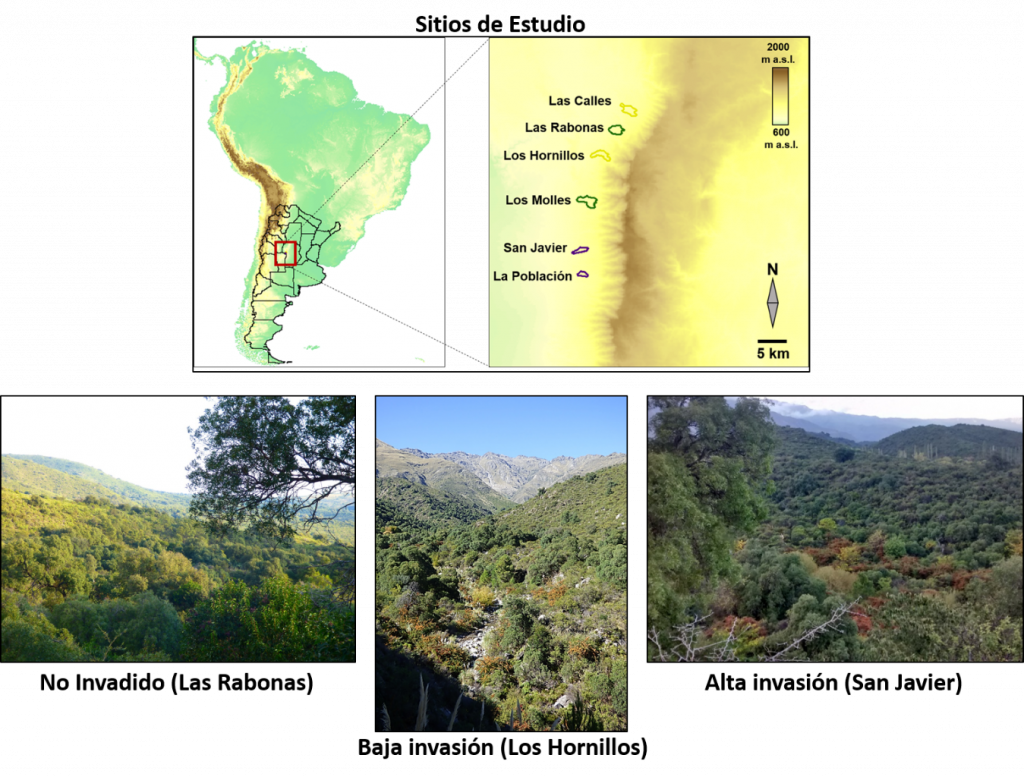- News / Native tree seed dispersal is favoured by the presence of invasive exotic plants that bear fruit at the same time
NEWS
Native tree seed dispersal is favoured by the presence of invasive exotic plants that bear fruit at the same time
In a study carried out in the mountains in central Argentina (Vergara-Tabares DL, Blendinger PG, Tello A, Peluc SI, Tecco PA; Fleshy-fruited invasive shrubs indirectly increase native tree seed dispersal; Oikos https://onlinelibrary.wiley.com/doi/full/10.1111/oik.08311), we found that the fruiting of invasive exotic shrubs (different Pyracantha species) has a positive effect on the seed dispersal of Lithraea molleoides, one of the most charismatic native tree species of the region. This study was the result of a postdoctoral project financed by CONICET to David Vergara-Tabares.
Invasive exotic plants are species that have been moved outside their range and that establish new populations in the wild areas where they were introduced. Biological invasions provide excellent opportunities for the investigation of ecological problems. In this case, we studied the indirect effects of the invasions of plants with fleshy fruits on the mutualisms between plants and native frugivores. Not only is it an interesting phenomenon in its own right, it also offers an attractive study system for evaluating indirect density-dependent effects between plant species.
In the frugivory and seed dispersal mutualisms, animals that consume fruits take advantage of the pulp as food and deposit the seeds far from the mother plant. However, during the invasion process, an exotic plant can indirectly affect the interactions between native species by integrating into a native community. Although this effect is usually considered to be negative, as invaders compete for existing frugivores with native plants leading to less fruit removal and seed dispersal in native plants, positive effects are also possible. Since frugivorous birds have the ability to track sites with greater abundance of food, the fruiting of invasive plants can disproportionately increase the abundance of frugivores in a community, thus increasing the dispersal of seeds of native plants that fructify synchronously with invasive species.

FIGURE 1: The study sites are shown above and the three invasion conditions considered in the study are exemplified below. In the images of the invaded sites (Los Hornillos and San Javier), individuals of Pyracantha can be seen with their orange and red fruits during autumn.
In the Chaco Serrano forests of central Argentina (FIGURE 1), invasive plants fruit in autumn and winter during periods of food scarcity, decoupled with the fruiting period of most native plants. However, the native tree species Lithraea molleoides fructifies from summer to early winter, partially overlapping with the onset of invasive species fruiting. The fruiting of invasive shrubs of the genus Pyracantha temporarily provides a new and abundant food resource that promotes an increase in the abundance of seed-dispersing birds. This partial overlap allows testing opposite predictions regarding the effect of invaders on native seed dispersal (FIGURE 2). It also generates landscapes with contrasting densities of invasive plants, providing an opportunity to investigate whether the invasion of Pyracantha spp. interrupts or facilitates seed dispersal mutualism between native species. In this study, we compared the fruit consumption of Lithraea molleoides by seed dispersal birds during periods of non-overlap and overlap with invasive plants, at six sites with different Pyracantha shrub densities (high, low, and no invasion).

FIGURE 2. Predictive scenarios that may operate in the dispersal of Lithraea molleoides seeds in sites not invaded and invaded by Pyracantha spp., an exotic shrub with fleshy fruits. (a) Interruption of mutualism: fruit removal is reduced when Pyracantha fruit supply starts (autumn); (b) facilitation of mutualism: the removal of fruits increases with the increase of Pyracantha fruit supply; (c) the level of fruit supply of the invaders (neighbourhood effect) modulates the sign of the interaction, with a breakdown of mutualism when the supply of invasive fruits is high and facilitation when the supply is low.
Lithraea molleoides fruit removal by birds (PHOTO 1) was similar between all sites during the period without overlap and remained constant in both periods at non-invaded sites. However, in invaded sites, fruit consumption increased during the overlapping period and was higher in highly invaded sites. In other words, the fruit resource provided by Pyracantha did not interrupt the seed dispersal of the dominant native tree, moreover, it facilitated seed dispersal and this effect was exacerbated with the increase in invaders fruit supply.
In this study, we show that the availability of invasive fruits promotes the consumption of fruits in a native tree, which contrasts with previous findings from other studies on this indirect effect. Furthermore, the magnitude of the increase in the consumption of native fruits was modulated by the density of the invasive plants. These results demonstrate that the increase in the general availability of fruits in sites invaded by exotic plants positively affects the removal of fruits from a native tree by seed-dispersing birds, and highlight the dynamism of indirect effects in different contexts or stages of invasion. This study also represents one of the few on the indirect effects of invasive plants on native seed dispersal mutualisms. In order to evaluate the net consequences of the effects of invasive plants on the recruitment of new individuals of native species, it remains to be studied whether this benefit is maintained during germination and the establishment of new plants.
Link to the article: https://onlinelibrary.wiley.com/doi/full/10.1111/oik.08311